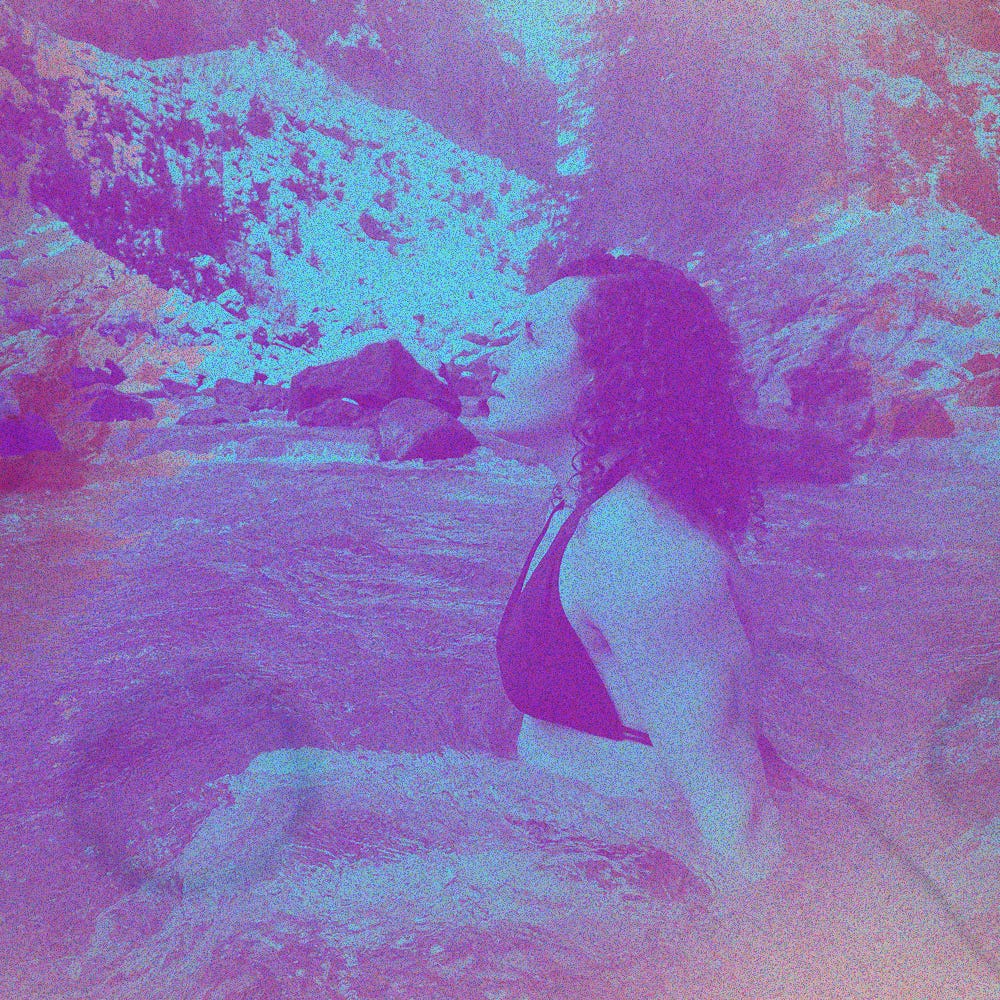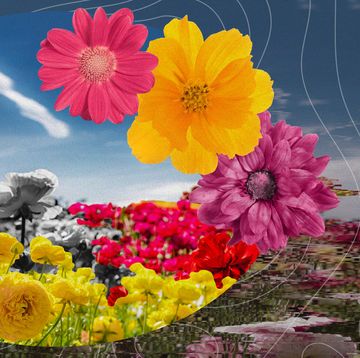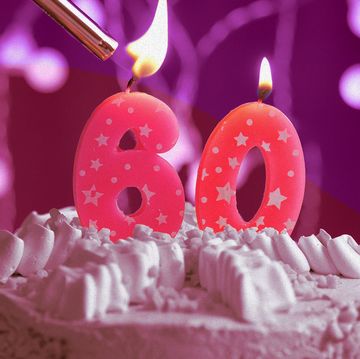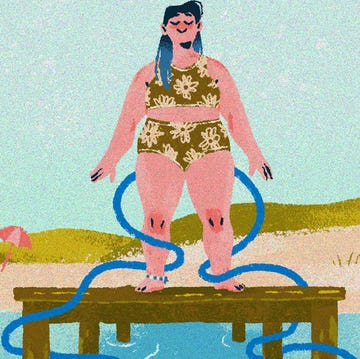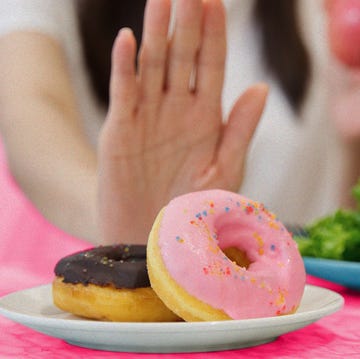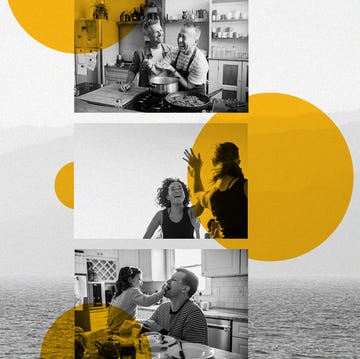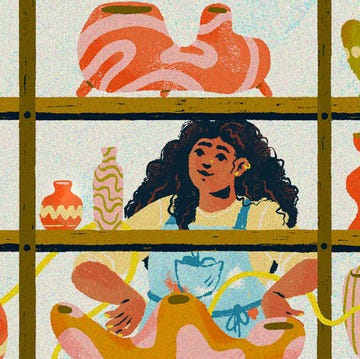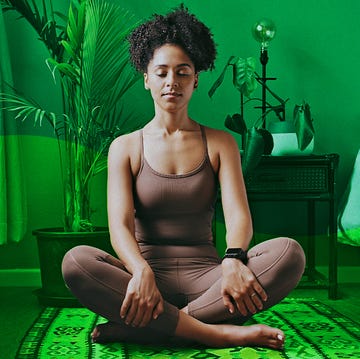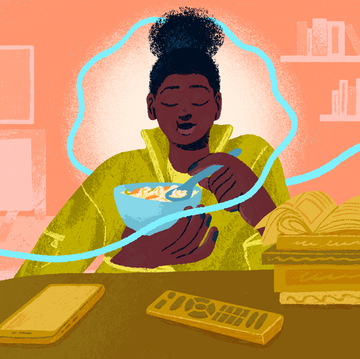Somewhere along the line, society has popularized the Eat Pray Love-style of finding yourself. And hey — we’re not opposed! If you have the time and resources for an extended trip around the world to indulge in spiritual practices, hotties, and eating your face off, by all means go for it.
But for most of us, going to extremes in order to learn something about ourselves or reach some kind of enlightenment isn’t always viable, even if the temptation to change everything with the new year is strong, thanks to being constantly inundated with ads for diets, skincare, gyms, and language-learning apps. So, the question becomes how do you set out on an intentional path to find yourself when daily life keeps getting in the way?
The answer — slow, incremental change — isn’t exactly sexy. After all, we’re an “I want it now” society, and for many, if gratification isn’t instant, then it’s easier to just give up rather than stay the long, possibly winding course to change.
Even so, we love the idea of starting a hero’s journey with intentional decisions and incremental change instead of turning your world on its head as you try something new. So, if you’re ready to take the leap to new, sustainable self-discovery, we’ve gathered a few experts to share how they’ve found themselves without losing the plot.
If you are going to make a big change, honor the part of yourself you already know
If saying, “YOLO,” and making a major change like quitting your job, shaving your head, or skipping the country is a non-negotiable part of your self-exploration, then have at it. But before you pick up those clippers or forward your mail, consider what practical steps need to happen in order for you to thrive during your time of transition.
Nneya Richards, a New York and Italy-based travel expert, admits that on the surface, her time of self-discovery reads a bit like Elizabeth Gilbert cosplay. In 2016, tired of the frequent travel required by her job, she set down roots for an extended two-month stay in Paris, followed by a planned month in London. She was alone but not isolated as she went on Bumble dates for dinner companions and learned to embrace the joy of bringing a book to a café — two practices that made it easier for her to lean into her surroundings when she moved on to London, where friends and family meant that she was never fully alone.
But what stood out for her, almost as much as the ability to do some slower exploring in her adopted cities or meeting her now-husband, was the peace of mind she gained by making sure that her reentry was successful.
“I love being home, and I loved my space in Brooklyn,” says Richards of her apartment, which she eventually put on Airbnb. “In my head, I didn’t have it set up to be a rental. I didn’t want random people in my house. But [I asked a friend] to put locks on the closet, and then I was like, ‘I could choose this.’ … That’s what gave me the kick in the butt to be able to financially securely leave New York, because the rent was taken care of. I couldn’t really live the full experience if I was like, ‘My stuff is being stolen back in New York,’ or if a month before I decided to come back to the U.S., I spent that time thinking, ‘I have to start looking for an apartment!’”
Before you take the big leap, it’s worth checking in with yourself to determine your comfort zones. Would keeping your job while starting your dream business allow you to comfortably create without losing sleep? Will plugging in to local communities take the pressure off relocating with your partner? Are you ready for bangs — but not that fire-engine red hair you’ve been eyeing? Don’t be ashamed of embracing practicality while stepping into the unknown.
Joyfully give things up
When we talk about abstaining from something, it’s usually a discussion rooted in deprivation. That’s something that Kenzie Brenna, a body-positive content creator from Vancouver, Canada, is hoping to change. As a public figure, she’s gotten used to sharing everything from housing issues to dog adoption to her relationship to her body. So, when she decided to spend four months not pursuing any romantic and/or sexual connections, it was something she addressed with her audience.
“I don’t think that we are able to fully find freedom until we can have choice to do something or to not do something,” she says. “I would say two things that have been consistent for most of my life is having a disordered relationship with food and a disordered relationship with men. Those two things have been so enmeshed in my identity that for me to address them is for me to address myself. Who am I without using food as an emotional regulator? Who am I without using men as a way to feel excited, good, and happy about myself in my life?”
To avoid white-knuckling until the end of April, Brenna has framed her decision not as a void, but rather as an opportunity to meditate, focus on platonic relationships, and work on her career while fostering other hobbies. She also hints that after her self-prescribed four-month break, she might even consider extending it further if she’s mentally in a place she’d like to explore more — another added element of flexibility that has given her peace in her decision.
“There’s almost this detoxing that happens, where you’re nervous or you don’t feel complete doing things without seeking romance,” Brenna says. “I’m finally at a place where I feel like all of these things are so exciting and make me whole and put me into a place of feeling abundance. But I had to go through that period of feeling extremely hollow and not feeling like there was joy in any of those activities without the background noise of seeking a partner. I’m not going to do this alone forever, and I think we really have to honor those dark spaces and really befriend them before you can cross the bridge and see the light and feel the goodness that comes from limiting your choice.”
Embrace the familiar with new guidelines
Maybe you’re interested in going completely cold turkey. Or maybe your goal is to explore an area of your life that can’t be fully eliminated. (See: food, work, shopping.) Which is why, says Alyssa DeHayes, who curates the online Western-wear shop Greta et Cetera, it’s worth exploring something familiar with new guidelines. As she recalls, deciding to only buy secondhand for a year didn’t stem from a shopping addiction or an addiction to fast fashion but rather from simply trying something new.
“I love clothes a lot,” she says. “There’s something about a buy-nothing new year that forces you to be thoughtful rather than just being like, ‘I’m gonna go browse a store and grab whatever I see.’ If I did want something, like if there was a particular garment, it was like, ‘Okay, well, now we’re going to take time on eBay or Poshmark and see if I can find one that’s in my size and is what I’m picturing in my head.’ And that also gives you the opportunity along the way to be like, ‘Do I really want this that badly?’”
The exercise also helped DeHayes better define her own style preferences. What she discovered was that sometimes a little tweak goes a long way — a lesson likely to decrease your carbon footprint and increase your overall satisfaction as a consumer.
“I finally prioritized tailoring things in my closet that I’ve had forever but wasn’t really wearing,” she says. “I realized that I basically already had a closet full of things. They’re kind of everything I need. There were just little tweaks like, ‘I don’t like how this sits on my hips’ or ‘The sleeves are a little wrong.’ And just those little tweaks really showed me both how I like things to fit and how I like things to be tailored. And also, they helped me figure out what is not my style. If there’s something in my closet that I didn’t like enough to spend $15 to $20 to get tailored to fit me, then it’s probably not for me.”
Explore physical extremes
Regardless of what your brain might be telling you, you do not have to disappear on a marathon hike into the woods or become a 24-7 gym rat in order to discover a new physical side of yourself. Sometimes, as Henriette Sophia Danielsen, a communication adviser from Stockholm, Sweden, explains, exploring physical extremes can be as easy as finding a new form of movement. Do you walk? Try running. Have you been lifting weights? Hit the pool. Looking to make new friends? Join a local adult sport team.
For Danielsen, that process led her to embracing cold water and ice swimming, something that, despite a love of water, she had never tried. With the help of a local club named Badfruarna (which translates to “Ladies Who Swim”), which offered both accountability and unexpected community, Danielsen was able to make her chilly dips a habit and fell in love with the feeling of embracing the cold, an intense sensation that also helps her slow down and focus on what’s really important.
“2022 was a hard year for me, struggling with anxiety for the first time and having lost a beloved family member,” Danielsen says. “Swimming actually turned out to help me re-center, bringing me into the right now by simply focusing on my breath. And that type of mindfulness is rare for me. When you are in the water, with ice around you and minus degrees in the air, you don’t think about work, bills that need to be paid, or whatever else that might worry you, or whatever has caused you hurt or pain. Cold and ice swimming is about getting away from distraction and calming down, being in that moment and in that breath. … I have always been running from, and trying to avoid, uncomfortable situations. What the cold and ice swimming has taught me is to lean into the uncomfortable and accept it. Because that’s where the magic happens.”
Accept that you may never have all the answers
Maybe you’ve already learned it through personal experience, but the process of finding yourself never really ends. A large part of finding peace in the process is embracing the lack of an end point.
For Nabil Ayers, it was embracing personal evolution that allowed him to write his memoir, My Life in the Sunshine. It was never a secret that he is the son of jazz musician Roy Ayers, or that his mother actively decided to be a single mother. However, when meeting his father in his 30s for lunch didn’t answer every question he had about his side of the family, Ayers found himself digging even deeper.
“I learned a lot, but mostly I learned that it’s a much longer process than one lunch,” he says. “When my father wasn’t willing to meet again, I had to go out on my own and search out other family members. It was scary — it still is — but I’m thankful for the many wonderful people I’ve found and the information they’ve provided.”
While the book is published, Ayers’ story is far from over. Through book events staged across the United States (and a few in Europe), he’s managed to connect with more family members and people who knew his father. And with each new connection, he’s given another tiny piece of his personal puzzle.
“We all have core beliefs and values, but mine aren’t exactly the same as they were 20 years ago,” he says. “We’re always learning, and so much of my process has been connecting with people to whom I’m related or closely connected. The more I learn about my father and my ancestors, the more my sense of identity shifts. I’ve literally rolled up to a book event and thought, ‘I wonder if I’ll feel differently about myself one hour from now.’”
Laura Studarus is a Los Angeles-based travel writer who has contributed to Fast Company, BBC Travel, and Thrillist. Follow her on Twitter at @Laura_Studarus.
Get Shondaland directly in your inbox: SUBSCRIBE TODAY
